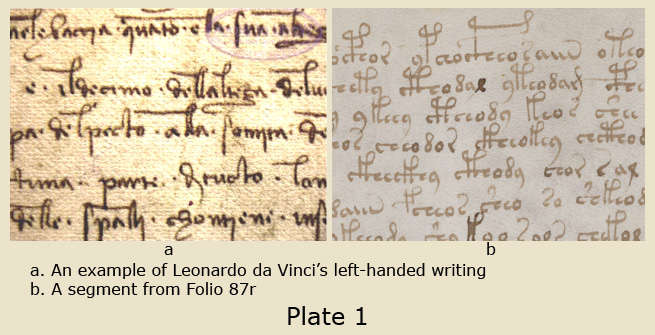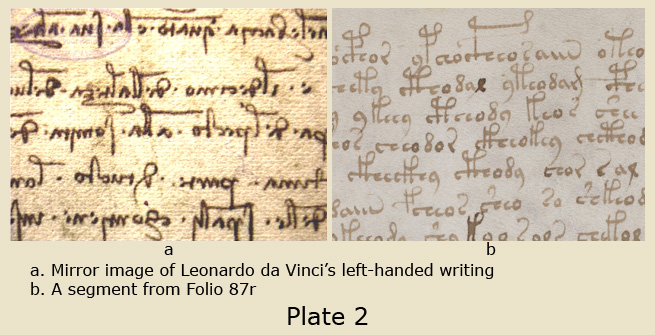The Handwriting of Leonardo da Vinci and the Voynich Manuscript
There are three classes of people, those who see,
those who see when they are shown, and those who do not see.
— Leonardo da Vinci
I was introduced to the Voynich Manuscript about thirteen years ago. My immediate reaction on viewing selected folios from the VM was that the script closely resembled the handwriting of Leonardo da Vinci, an observation also noted by the son of Robert S. Brumbaugh (The Most Mysterious Manuscript, ed R.S. Brumbaugh, Southern Illinois University Press 1978, p 117). This and other factors led me to formulate the hypothesis that the VM was written by a young Leonardo da Vinci. Over the following years I wrote a number of articles supporting this hypothesis. Recently, I received an email from Tania Ocampo, who wrote that she considered that Leonardo and the author of the VM have very similar handwriting. She sent me a sample of Leonardo’s writing that provides additional proof that my hypothesis that Leonardo wrote the VM may be correct. I emailed Tania, suggesting that she either put this sample of Leonardo’s writing up on the internet or, if this was difficult for her to do, I would do it for her, giving her the credit for a very useful observation. This is the reason I am writing this article.
The VM is written from left to right and from top to bottom by an individual writing with their right hand. It is very well known that Leonardo was left handed. His notebooks were written from right to left using mirror image script. These books were private, written for his eyes only. He wrote in a conventional manner, from left to right, when he wished to communicate with other people. Leonardo celebrated the fact that he defied public convention, declaring ‘I o mancino’, I am left handed. Left-handed people were called southpaws and accused of practicing witchcraft. The Devil himself was considered to be a leftie. People writing from left to right, when using their left hand, tend to smudge the ink as their hand moves across the page. Left-handed children were forced to write with their right hand, a practice that continued until the beginning of the 20th century. Leonardo would have been taught to write with his right hand and probably only rebelled against this convention when he became an adult. If you read my article ‘Was the Author of the Voynich Manuscript Left-handed’, I show that although the script is right-handed, the hatching in the drawings was done by a individual using his left hand.
- The VM uses a unique alphabet with over 30 different symbols, most of them unlike any other alphabet. A number of attempts have been made to transcribe of the VM alphabet, the one generally accepted is known as ‘The European Voynich Alphabet’ EVA.
- An individual’s handwriting matures with age. There are no examples of Leonardo’s childhood handwriting. The earliest known example of his script is from 1473, when he was 21 years old. It was decorated with exaggerated curlicues and flourishes, similar to the embellishments found in the VM script. As he matured, these embellishments disappeared and his handwriting became utilitarian.

Plate 1 is a comparison of a sample of Leonardo’s writing provided by Tania, with text from VM plant folio No. 87r.

Plate 2 is a comparison of the mirror image of this sample with the same text. The scripts appear to be very similar. I am not a handwriting expert, but I have no difficulty in believing that Leonardo’s left hand wrote the example that Tania sent me and his right hand wrote the VM example.
I have been unable to determine the notebook Tania’s script came from, but it may be found on several web sites relating to Leonardo’s handwriting.
I dedicate this article to my 10 year old grandson. One day recently, he was looking over my shoulder while I was reading an article on the VM. He exclaimed, “I didn’t know that you knew about the Voynich Manuscript.” and proceeded to tell me all about the manuscript, including naming the missing folios. He had read the children’s book ‘Trust No One’ by Linda Sue Parks, book 5 from the series, 39 Clues. Perhaps this book should be added to the inventory of books about the VM.